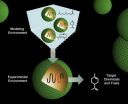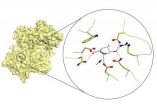(Press-News.org) A new study describes how a complex genomic rearrangement causes a fascinating phenotype in chickens in which a massive expansion of pigment cells not only makes the skin and comb black, but also results in black internal organs. Published in PLoS Genetics, researchers at Uppsala University, the Swedish University of Agricultural Sciences, North Carolina State University, and National Chung-Hsing University investigated the genetic basis of fibromelanosis, a breed characteristic of the Chinese Silkie chicken.
"We have shown that the genetic change causing fibromelanosis is a complex rearrangement that leads to increased expression of Endothelin 3, a gene known for promoting the growth of pigment cells," explains Ben Dorshorst, one of the authors.
The genetic changes underlying the evolution of new species are still poorly understood. For instance, we know little about critical changes that have happened during human evolution. Genetic studies in domestic animals can shed light on this process due to the rapid evolution they have undergone over the last 10,000 years.
The research group, led by Leif Andersson, has characterized a number of traits in domestic animals, and a clear trend is emerging: genomic rearrangements have contributed significantly to the rapid evolution of domestic animals.
"We have good reason to believe that such rearrangements have also played a significant role in the evolution of other species, including ourselves," concludes Leif Andersson.
###
FINANCIAL DISCLOSURE: The project was funded by the Swedish Foundation for Strategic Research, the Swedish Research Council, and the Swedish Research Council for Environment, Agricultural Sciences, and Spatial Planning. AMJ received funding from the Royal Swedish Academy of Agriculture and Forestry (KSLA) to support collection of Swedish chicken breed samples. The funders had no role in study design, data collection and analysis, decision to publish, or preparation of the manuscript.
COMPETING INTERESTS: The authors have declared that no competing interests exist.
CITATION: Dorshorst B, Molin A-M, Rubin C-J, Johansson AM, Stro¨ mstedt L, et al. (2011) A Complex Genomic Rearrangement Involving the Endothelin 3 Locus Causes Dermal Hyperpigmentation in the Chicken. PLoS Genet 7(12): e1002412. doi:10.1371/journal.pgen.1002412
CONTACT: Professor Leif Andersson, Department of Medical biochemistry and microbiology, Uppsala university, phone: 46-18-471 4904, 46-70-514 4904, e-post: Leif.Andersson@imbim.uu.se
Disclaimer
This press release refers to an upcoming article in PLoS Genetics. The release is provided by journal staff, or by the article authors and/or their institutions. Any opinions expressed in this release or article are the personal views of the journal staff and/or article contributors, and do not necessarily represent the views or policies of PLoS. PLoS expressly disclaims any and all warranties and liability in connection with the information found in the releases and articles and your use of such information.
About PLoS Genetics
PLoS Genetics (http://www.plosgenetics.org) reflects the full breadth and interdisciplinary nature of genetics and genomics research by publishing outstanding original contributions in all areas of biology. All works published in PLoS Genetics are open access. Everything is immediately and freely available online throughout the world subject only to the condition that the original authorship and source are properly attributed. Copyright is retained by the authors. The Public Library of Science uses the Creative Commons Attribution License.
About the Public Library of Science
The Public Library of Science (PLoS) is a non-profit organization of scientists and physicians committed to making the world's scientific and medical literature a freely available public resource. For more information, visit http://www.plos.org.
Rapid evolution in domestic animals sheds light on the genetic changes underlying evolution
A complex genomic rearrangement causes a fascinating phenotype in chickens in which a massive expansion of pigment cells not only makes the skin and comb black, but also results in black internal organs
2011-12-23
ELSE PRESS RELEASES FROM THIS DATE:
Chinese fossils shed light on the evolutionary origin of animals from single-cell ancestors
2011-12-23
All life evolved from a single-celled universal common ancestor, and at various times in Earth history, single-celled organisms threw their lot in with each other to become larger and multicellular, resulting, for instance, in the riotous diversity of animals. However, fossil evidence of these major evolutionary transitions is extremely rare.
The fossils, reported this week in Science, preserve stages in the life cycle of an amoeba-like organism dividing in asexual cycles, first to produce two cells, then four, eight, 16, 32 and so on, ultimately resulting in hundreds ...
Canine Trade Group Opens New 300-Acre Training Facility in Dover, Delaware
2011-12-23
One of the most extensive US-based dog training companies, Canine Trade Group, is proud to introduce a new 300 acre training facility in Dover, Delaware where its Professional Dog Trainer's Course will be held. Owned and operated by world-renowned dog trainer John Van Olden, Canine Trade Group offers customized training programs for dog trainers and their dogs. The new Dover Training Facility boasts a private, 20-run climate controlled kennel, an abundance of training field space, as well as accommodations such as on-site lodging or a country inn located less than a mile ...
Scientists engineer mosquito immune system to fight Malaria
2011-12-23
Researchers at the Johns Hopkins Malaria Research Institute have demonstrated that the Anopheles mosquito's innate immune system could be genetically engineered to block the transmission of malaria-causing parasites to humans. In addition, they showed that the genetic modification had limited impact on the mosquito's fitness under laboratory conditions. The researchers' findings are published December 22nd in the Open Access journal PLoS Pathogens.
In this study, Dimopoulos and his team genetically engineered Anopheles mosquitoes to produce higher than normal levels ...
Double trouble: Concomitant immune challenges result in CNS disease
2011-12-23
A research team led by Glenn Rall at the Fox Chase Cancer Center in Philadelphia, PA developed a novel mouse model to show that a fatal central nervous system (CNS) disease can be caused by a pathogen that does not replicate in the CNS. The results of this new study are published December 22nd in the Open Access journal PLoS Pathogens.
The authors found that the immune response induced in response to a peripheral viral infection can be "mis-recruited" to the brain, where these activated immune cells can then lead to inflammation-induced neuropathology and disease. While ...
CAD for RNA
2011-12-23
The computer assisted design (CAD) tools that made it possible to fabricate integrated circuits with millions of transistors may soon be coming to the biological sciences. Researchers at the U.S. Department of Energy (DOE)'s Joint BioEnergy Institute (JBEI) have developed CAD-type models and simulations for RNA molecules that make it possible to engineer biological components or "RNA devices" for controlling genetic expression in microbes. This holds enormous potential for microbial-based sustainable production of advanced biofuels, biodegradable plastics, therapeutic ...
For every road there is a tire
2011-12-23
KANSAS CITY, MO -- Life is complicated enough, so you can forgive the pioneers of DNA biology for glossing over transcriptional elongation control by RNA polymerase II, the quick and seemingly bulletproof penultimate step in the process that copies the information encoded in our DNA into protein-making instructions carried by messenger RNA.
In a new report appearing in the Dec. 23, 2011, issue of Molecular Cell, researchers at the Stowers Institute for Medical Research add not just a new layer, but a whole new dimension to transcriptional elongation control with evidence ...
Facebook Marketing Strategist Shows Chiropractors How to Get Endless New Patient Referrals from Social Media
2011-12-23
Chiropractic Internet marketing strategist and social media expert, Dr. Matthew Loop, has announced he'll continue to show DCs how to create an overwhelming presence on Facebook, which can easily net doctors an extra 20-30 new patients per month just from the social network. Dr. Loop's been helping fellow chiropractors master social media marketing since 2005-2006, which gives him an experience-based edge over other industry consultants.
He's garnered a well deserved reputation as the "go-to" guy for chiropractors that want to dramatically improve their new ...
Gene fusion in lung cancer afflicting never-smokers may be target for therapy
2011-12-23
December 22, 2011 – Smoking is a well-known risk factor for lung cancer, but nearly 25% of all lung cancer patients have never smoked. In a study published online today in Genome Research (www.genome.org), researchers have identified a previously unknown gene fusion event that could explain a significant proportion of lung cancer cases in never-smokers, and might serve as a target for new therapies.
Recent strides have been made to identify gene mutation events driving cases of lung adenocarcinoma in never-smokers, but the underlying genetic events leading to these lung ...
DNA mismatch repair happens only during a brief window of opportunity
2011-12-23
In eukaryotes – the group of organisms that include humans – a key to survival is the ability of certain proteins to quickly and accurately repair genetic errors that occur when DNA is replicated to make new cells.
In a paper published in the December 23, 2011 issue of the journal Science, researchers at the Ludwig Institute for Cancer Research and the University of California, San Diego School of Medicine have solved part of the mystery of how these proteins do their job, a process called DNA mismatch repair (MMR).
"One of the major questions in MMR is how MMR proteins ...
Biochemists develop promising new treatment direction for rare metabolic diseases
2011-12-23
AMHERST, Mass. – A research team led by biochemist Scott Garman at the University of Massachusetts Amherst has discovered a key interaction at the heart of a promising new treatment for a rare childhood metabolic disorder known as Fabry disease. The discovery will help understanding of other protein-folding disorders such as Alzheimer's, Parkinson's and Huntington's diseases, as well. Findings are featured as the cover story in the current issue of Chemistry & Biology.
People born with Fabry disease have a faulty copy of a single gene that codes for the alpha-galactosidase ...
LAST 30 PRESS RELEASES:
URI researchers uncover molecular mechanisms behind speciation in corals
Chitin based carbon aerogel offers a cleaner way to store thermal energy
Tracing hidden sources of nitrate pollution in rapidly changing rural urban landscapes
Viruses on plastic pollution may quietly accelerate the spread of antibiotic resistance
Three UH Rainbow Babies & Children’s faculty elected to prestigious American Pediatric Society
Tunnel resilience models unveiled to aid post-earthquake recovery
Satellite communication systems: the future of 5G/6G connectivity
Space computing power networks: a new frontier for satellite technologies
Experiments advance potential of protein that makes hydrogen sulfide as a therapeutic target for Alzheimer’s disease
Examining private equity’s role in fertility care
Current Molecular Pharmacology achieves a landmark: real-time CiteScore advances to 7.2
Skeletal muscle epigenetic clocks developed using postmortem tissue from an Asian population
Estimating unemployment rates with social media data
Climate policies can backfire by eroding “green” values, study finds
Too much screen time too soon? A*STAR study links infant screen exposure to brain changes and teen anxiety
Global psychiatry mourns Professor Dan Stein, visionary who transformed mental health science across Africa and beyond
KIST develops eco-friendly palladium recovery technology to safeguard resource security
Statins significantly reduce mortality risk for adults with diabetes, regardless of cardiovascular risk
Brain immune cells may drive more damage in females than males with Alzheimer’s
Evidence-based recommendations empower clinicians to manage epilepsy in pregnancy
Fungus turns bark beetles’ defenses against them
There are new antivirals being tested for herpesviruses. Scientists now know how they work
CDI scientist, colleagues author review of global burden of fungus Candida auris
How does stroke influence speech comprehension?
B cells transiently unlock their plasticity, risking lymphoma development
Advanced AI dodel predicts spoken language outcomes in deaf children after cochlear implants
Multimodal imaging-based cerebral blood flow prediction model development in simulated microgravity
Accelerated streaming subgraph matching framework is faster, more robust, and scalable
Gestational diabetes rose every year in the US since 2016
OHSU researchers find breast cancer drug boosts leukemia treatment
[Press-News.org] Rapid evolution in domestic animals sheds light on the genetic changes underlying evolutionA complex genomic rearrangement causes a fascinating phenotype in chickens in which a massive expansion of pigment cells not only makes the skin and comb black, but also results in black internal organs




